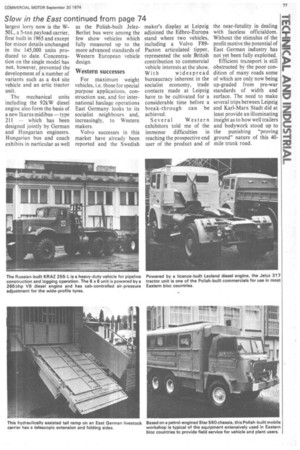Slow progress in the East
Page 76

Page 79

If you've noticed an error in this article please click here to report it so we can fix it.
Commercial vehicles at Leipzig
by special correspondent
THE EXPECTATION that a visit to the Leipzig Fair, after an interval of four years, would reveal considerable progress in the East German vehicle industry began to fade on the journey to the show earlier this month. Driving through East German towns and villages, strengthened the impression that there had been little change.
At Leipzig itself where much effort and material had been expended on political slogans celebrating the 25th anniversary of the German Democratic Republic, the country's indigenous industry had mounted a massive display including an outdoor area where all current production models — cars and commercials — provided demonstration runs. The largest crowds, however were on the stands of Western exhibitors, notably Mercedes-Benz, where East Germans hungry for technical know-how, waited patiently for the regular distribution of leaflets and brochures.
Under the mutually agreed rationalization of commercial vehicle production in the East bloc countries the German Democratic Republic's largest lorry now is the W50L, a 5-ton payload carrier, first built in 1965 and except for minor details unchanged in the 145,000 units produced to date. Concentration on the single model has not, however, prevented the development of a number of variants such as a 4x4 site vehicle and an artic tractor unit.
The mechanical units including the 92kW diesel engine also form the basis of a new I karu s midibus — type 211 — which has been designed jointly by German and Hungarian engineers. Hungarian bus and coach exhibits in particular as well as the Polish-built JelezBerliet bus were among the few show vehicles which fully measured up to the more advanced standards of Western European vehicle design.
Western successes
For maximum weight vehicles, i.e. those for special purpose applications, construction use, and for international haulage operations East Germany looks to its socialist neighbours and, increasingly, to Western makers.
Volvo successes in this market have already been reported and the Swedish maker's display at Leipzig adjoined the Edbro-Europa stand where two vehicles, including a Volvo F89Pacton articulated tipper, represented the sole British contribution to commercial vehicle interests at the show.
With widespread bureaucracy inherent in the socialist economy, trade contacts made at Leipzig have to be cultivated for a considerable time before a break-through can be achieved.
Several Western exhibitors told me of the immense difficulties in reaching the prospective end user of the product and of the near-futulity in dealing with faceless officialdom. Without the stimulus of the profit motive the potential of East German industry has not yet been fully exploited.
Efficient transport is still obstructed by the poor condition of many roads some of which are only now being up-graded from pre-war standards of width and surface. The need to make several trips between Leipzig and Karl-Marx Stadt did at least provide an illuminating insight as to how well trailers and bodywork stood up to the punishing "proving ground" nature of this 40mile trunk road.




































































































































































































































































































































































